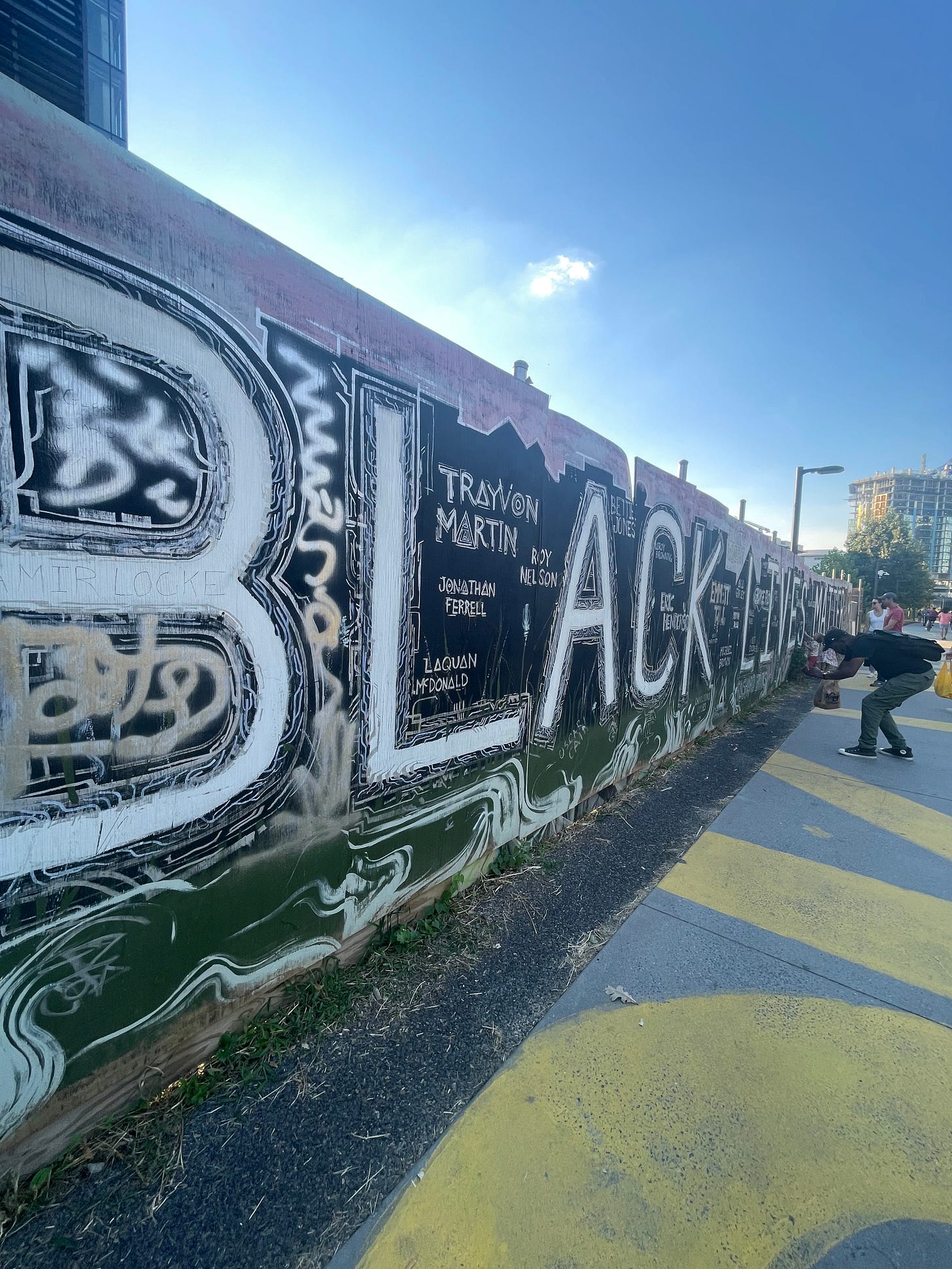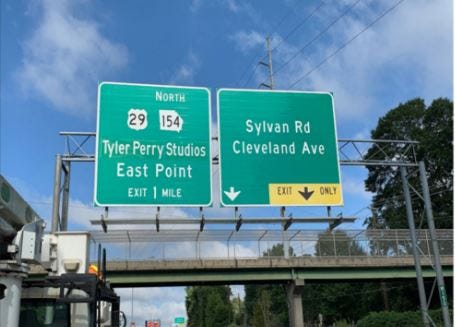Street art on the Beltline, Atlanta. Photo: Anne-christine d’Adesky. 2022.
I was in Atlanta this past week, for a quick four-day visit to help one of my daughters and her partner look for an apartment and tour a university. I made a shorter version of the Atlanta college tour last year, when it was colder and Covid had shuttered many schools. This time I stayed with a friend from Los Angeles who is working on a Marvel Black Panther-spinoff television series and her beyond-adorable daughter, age two-and-a-half. They were renting a big Victorian-style house in Inman, a liberal neighborhood dotted with political yard signs championing popular Democrats including powerhouse and would-be governor Stacey Abrams and Senator Ralphael Warnock. Both are fighting tough races. Abrams’ dazzling gap-toothed smile and quotes greeted me from one block to another.
While Brooklyn has gotten almost cold, it was still warm and almost balmy in Atlanta. I had my first view of the glories of fall, with a harvest of red and orange and yellow leaves carpeting the sidewalks of neighborhoods. Atlanta was in full blossom, and I appreciated the rich mix of its natural diversity, with a dense covering of green trees and wildflowers and shrubs bursting with color everywhere. On day two, I slipped over to the Beltline, which is a snaking 22-mile corridor of paved pathway that connects the city’s 45 neighborhoods and serves as a central meeting hub for neighbors, walkers, bikers, and visitors of every stripe. It’s a beautiful civic project, and was controversial, I learned. Its development came at a high cost to some neighborhoods where houses were razed, and people displaced. I immediately thought to myself that they were probably the poorer, Black and Brown residential areas that are now gentrifying along with every other area, making it unaffordable for the poorest.
Right now, Atlanta remains a super-hot metropolitan magnet for Black and Brown talent and businesses, including the movie business. White migration to the city has risen there, too. Tyler Perry has a new studio set up here; so do other big names in the film and television industry. For a young Black woman like my daughter, it’s an exciting city full of opportunities. It’s also more affordable than New York or San Francisco or Los Angeles or Miami—though it’s still hard to find a place. As you drive around, there’s construction everywhere: the city is booming.
The Atlanta trip nurtured my curiosity to learn more about the history of this great Southern capital, particularly because of its identity as a center of the civil rights movement, the place where Martin Luther King and the Student Nonviolent Coordinating Committee galvanized the fight for Black rights, and against the systemic racism that girds American society. Driving around Atlanta last year, I noted the little historic markers all over, detailing key events and leaders in Black history.
On sacred ground: W.E.B. DuBois, writer, scholar, activist.
Photo: Anne-christine d’Adesky. 2022.
On day two, we toured Clark Atlanta, which, I learned, is the oldest HBCU, or historically black college or university, in the southern United States. I also learned, right away, that the ground in front of its main campus building is considered sacred ground, the spot where the famous Black scholar W.E.B. DuBois and other founders of the HBCU’s are revered for their commitment to Black education and their rage against white tyranny.
I already knew a bit about the social infrastructure of Atlanta and the role played by its three famous cojoined HBCUs: Spelman, Morehouse and Clark Atlanta – the last a merger of Clark and Atlanta universities. There’s also nearby Morris Brown college. The four HBCUs make up a thriving, expanding corner of the Atlanta University Center. When President Obama took office, Michelle Obama’s Spelman sorority sisterhood captured the international spotlight, showcasing the achievements of HBCUs and Black sororities in promoting women’s education and achievements. Spelman was again in the media eye when Angelina Jolie was spotted proudly dropping off her daughter, Zahara Jolie-Pitt, a freshman. The celebrity star power factor is definitely something Atlanta celebrates.
Stacey Abrams, I learned, is also a Spelman graduate, while Warnock, the former pastor of Atlanta’s famous Ebenezer Baptist Church, is a Morehouse man. If you spent more than a few minutes in Atlanta, the subject may turn to football, and someone is bound to mention the friendly rivalry of HBCUs. One thing I felt walking around Clark Atlanta was the great pride that its current residents—faculty and students—take in its mission and history, and their awareness of the larger historic project of education that is their treasured legacy.
There are other colleges including Agnes Scott in Decatur that are also centers of excellence with a reputation for supporting Black women students. Last year, we stopped by Agnes Scott and looked at a few schools that offer fashion merchandising degrees, which is my daughter’s focus. Clark Atlanta is among the top 20 private schools for that degree, so it’s been on our radar for a while.
Stacey Abrams yard sign.
My daughter loved the campus, and right away, from the first minutes, it struck me—and her—how different it felt from the other schools we’ve toured. She went to Mills College in Oakland for almost two years before taking a break. Mills was a draw because of its focus on women’s education and its diversity, including a nearly 40% LGBTQ student body. But it was still a very white college by comparison to an HBCU, and for my daughter, born in Rwanda, the difference is palpable. We felt it in everything. The it is Black culture and history and Black spirit and pride, and the stubborn fact and pain of white racism that’s also everywhere but harder to put a finger on sometimes. I watched my daughter take in people’s outfits, their snap! grrrll ways of greeting each other, their fashion-forward hair styles. She remarked on how well-dressed and polite the students seemed to her, compared to other schools we’ve been to. Pointing out a woman with a cascade of multicolored locs, she joked, I’m gonna have to up my game.
The student tour leaders were enthusiastic, happy to point out not only which historic person established which historic place, but the buildings where The Black Panther and Boyz in the Hood and other movie projects were filmed. Spike Lee has been a fixture on these campuses for years. Near a cafeteria, we spotted a long line of students waiting for their kicks. It was homecoming weekend, and Nike has made an exclusive deal to produce a limited edition of Clark Atlanta sneakers that cost students $120. The line had been forming for hours. Kids were snapping selfies, showing off and laughing, excited for the homecoming fun to come.
I thought then of W.E. B. DuBois, a prolific writer and one of the founders of the NAACP and champion of Pan-Africanism, and his rival Booker T. Washington, another giant of the anti-slavery movement after the Civil War. What would they make of today’s students? I thought of how incredibly proud and happy they’d be seeing so many young people attending the HBCUs, and celebrating their excellent football teams, their spirits filled with Black pride and leadership. Hardworking, fun-filled students. DuBois was briefly a Socialist and, by his student’s accounts, a stern, strict teacher who would have opposed the capitalist corporate Nike brand bling merger of celebrity and fashion. But he’d be cheering on Stacey Abrams and Raphael Warnock.
I also learned that DuBois was an early champion of female education and empowerment but withdrew his support for the American suffragettes because they failed to champion the fight of Blacks for equality and the right to vote. That was a foreshadowing of the fight Black feminists had to gain a voice in the 70’s and 80’s women’s rights movement. Undoing racism remains the pressing work of white-centered America and it’s still a critical issue to address inside progressive movements, too. We are rightly furiously focused on Trump as the dragon-headed, racist, red state GOP leader and enemy of equality, but he has many followers who live all around us, some in our homes. The fight for America’s soul is on this fall.
When I got back from Atlanta, I read a bit more about the founders of the HBCUs and Atlanta’s history, including the burning of the capital made infamous in Gone with The Wind, and the race riots of 1906 that affected black migration in the city, pushing workers into Summerhill, Vine City, and the West End. These areas later became centers of poverty and urban blight, marked by crime and drug activity. I read about how the city built an Olympic Stadium in the 1990s over the protests of Summerhill residents and in 2017, opened the glittering Mercedes Benz Stadium, a modern architectural gem locally known as the Falcons stadium, right next to Vine City. Today, the promised benefits of these big stadium projects have been slow to benefit nearby residents, though change is happening. But the poorest remain unhoused in the shadows of the shiny Falcons dome, while the fast-growing HBCUs struggle to find affordable housing for their students.
My daughter, Mariam, at Atlanta Underground.
Photo: Anne-christine d’Adesky. 2022.
We also visited Underground Atlanta, once a hot tourist attraction in the 1970s that some compared to Las Vegas. It’s gone through several evolutions and is still struggling to regain its popularity as a shopping and entertainment center. We caught a fashion show there – part of Atlanta’s Fashion Week – and saw a fancy couture show by a celebrated South African designer, David Tlale. I got a glimpse of stepping-out Hotlanta style there, too, including queer Atlanta. People were representing. I overheard two people debating Ye’s (ex-Kanye West) controversial embrace of White Lives Matter. That fool is not only crazy—he’s damn dangerous, said a tall drag queen, smoothing their hair. I have to draw the line. No, Ye, y’all went too far!
Mariam with designer David Tlale at Underground Atlanta.
Photo: Anne-christine d’Adesky. 2022.
Model at David Tlale fashion show, Underground Atlanta. October 8, 2022.
Photo: Anne-christine d’Adesky. 2022.
Elsewhere around town, I liked a lot of the street art that dots the city and the Beltline, much of it inspirational or pointed, including social commentary on Black Lives Matter and the need to hold America accountable for the murders of Travon Martin and others by the police (see picture, above top), all the while holding fast to the unfinished dreams of W.E.B. DuBois and Dr. King, and the new visions put forth by Abrams et al.
Effective leaders must be truth seekers and that requires a willingness to understand truths other than our own. That’s an Abrams quote I saw as I walked in the quiet natural beauty of a neighborhood on my last afternoon walk. The latest polls favor Brian Kemp over Abrams by eight points, so she’s got high odds to overcome. If she wins, Georgia will gain a dynamic visionary governor; if she loses, she’ll use the momentum from her campaign to keep mobilizing Georgians and other Americans to defeat the GOP in 2024.
I’m taking a long lens on freedom, read another street sign I liked. My freedom is your freedom, read another. And another: My freedom is not negotiable.
I like it here, my daughter summed up, taking in the HBCU campus scene and the restaurants and the edgy fashion and the quiet, leafy streets and the friendly vibe along the Beltline. I can feel the ancestors.
The Souls of Black Folk. W.E.B. DuBois. 1903.
LINKS:
It’s going to take more than $45 million* to help Vine City - Atlanta Magazine












History speaking to young and old alike. We hope the ancestors would smile upon this connection and this description. A related book of interest: "Red Hot City: Housing, Race, and Exclusion in Twenty-First-Century Atlanta" at https://www.ucpress.edu/book/9780520387645/red-hot-city.
Phenomenal ... I CAN FEEL IT